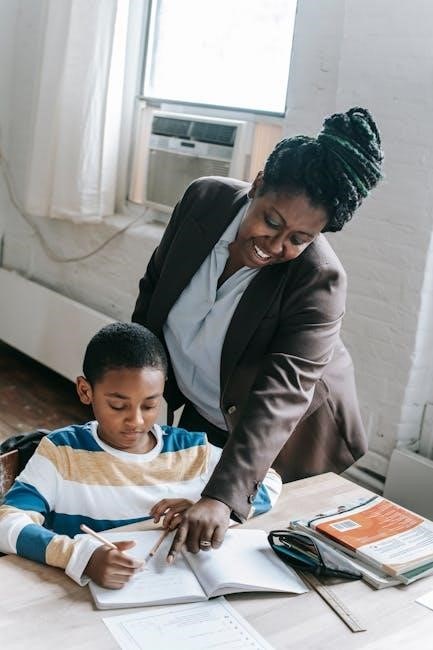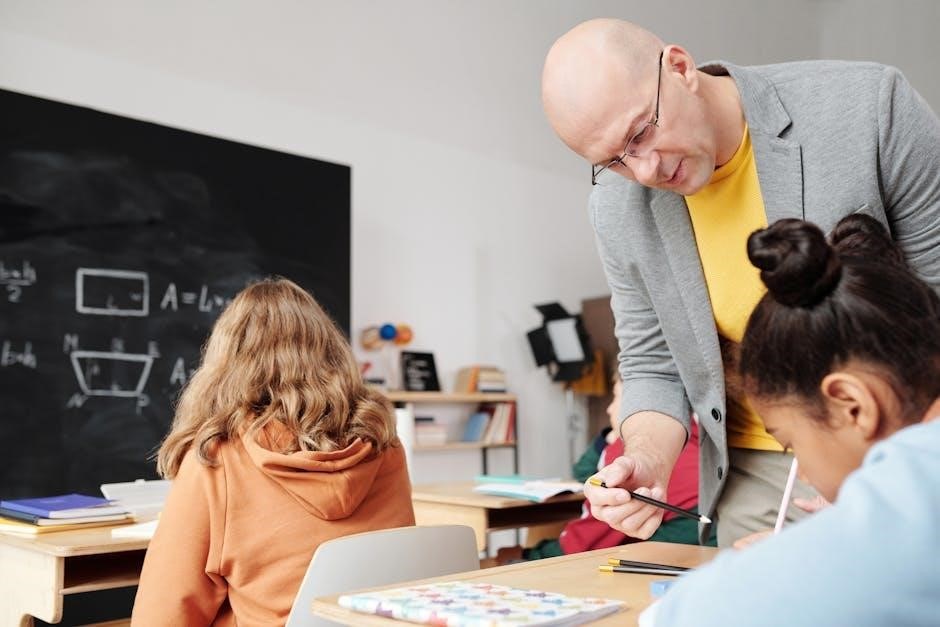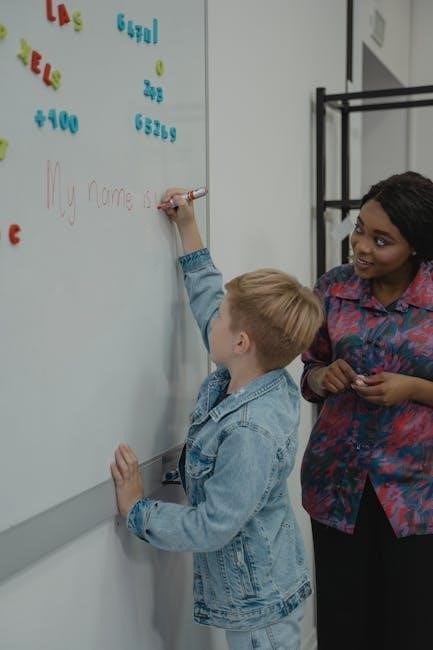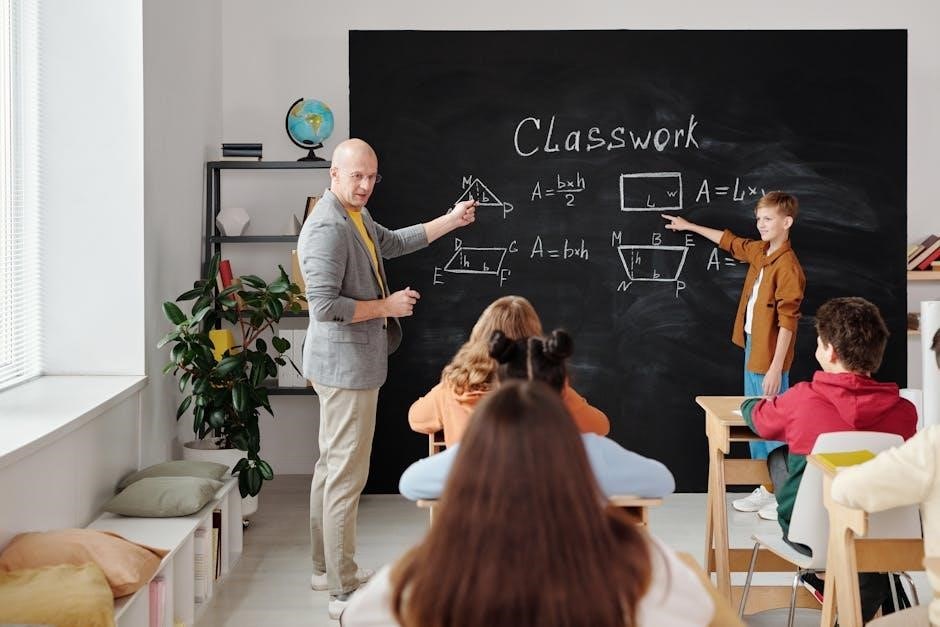The first instruction sets the tone, ensuring clarity and engagement while establishing routines. It shapes the classroom environment, fostering a positive and structured space for learning.

The First Instruction of a Teacher: Key Components
Setting clear expectations, encouraging active listening, and using icebreakers are essential. Introducing routines and fostering a positive environment ensure engagement and structure, laying the groundwork for effective learning.
Setting Clear Expectations
Setting clear expectations is crucial for establishing structure and accountability. Teachers should outline classroom rules, academic goals, and behavioral standards explicitly. This helps students understand what is expected of them, fostering a sense of responsibility and focus. By clearly communicating these expectations, teachers create a predictable learning environment, which reduces confusion and anxiety. Additionally, aligning expectations with learning objectives ensures that students are aware of the skills and knowledge they will acquire. This clarity also promotes a positive classroom culture, encouraging students to stay motivated and engaged. Clear expectations serve as the foundation for effective instruction, enabling both teachers and students to work collaboratively toward shared goals. This approach not only enhances academic performance but also helps students develop essential life skills, such as time management and self-discipline. Thus, setting clear expectations is a fundamental step in creating a productive and supportive classroom atmosphere.
Encouraging Active Listening
Encouraging active listening is vital for effective learning. Teachers should create an environment where students feel comfortable and engaged, fostering attentive behavior. Strategies include maintaining eye contact, asking open-ended questions, and incorporating think-pair-share activities. These methods ensure students are not just hearing but also processing and retaining information. Active listening also involves teaching students to avoid distractions, such as minimizing side conversations or electronic device use. By modeling attentive listening themselves, teachers demonstrate its importance. Encouraging students to paraphrase or summarize what they’ve heard helps confirm understanding. Non-verbal cues, like nodding or gesturing, can also reinforce engagement. Active listening builds a respectful classroom culture, where students value each other’s contributions. This practice enhances focus, critical thinking, and collaboration, laying a strong foundation for academic success. By prioritizing active listening, teachers empower students to become attentive, thoughtful, and engaged learners. This skill is essential for both academic achievement and lifelong communication.
Using Icebreakers for Engagement
Icebreakers are activities designed to help students feel comfortable and build connections in the classroom. They are especially effective during the first instruction, as they create a welcoming atmosphere and encourage participation. Simple games, group discussions, or interactive exercises can be used to break the ice. For example, asking students to share their names along with a fun fact about themselves can foster camaraderie. Icebreakers also help teachers gauge students’ personalities and communication styles. They reduce first-day jitters and make students more receptive to learning. Choosing age-appropriate and engaging activities ensures that all students feel included. Icebreakers not only ease transitions but also set a positive tone for the rest of the academic journey. By incorporating these activities, teachers can create a sense of belonging and lay the groundwork for a collaborative learning environment. This approach ensures that students are mentally and emotionally prepared to engage with the curriculum.
Introducing Classroom Routines
Classroom routines are essential for establishing structure and predictability, helping students understand expectations and transitions. These routines, introduced during the first instruction, include procedures for tasks like entering the classroom, submitting assignments, or beginning group work. Clear communication of these processes ensures smooth operations and reduces confusion. Teachers should demonstrate each routine and provide opportunities for practice. Consistency is key, as it helps students develop a sense of responsibility and accountability. Routines also minimize disruptions, allowing more time for instruction and engagement. Examples include raising hands to speak, using materials properly, or following cleanup protocols. By introducing routines early, teachers create an organized environment that supports learning and fosters discipline. These practices help students feel secure and focused, laying a strong foundation for academic success. Effective routines also empower students to manage their time and resources efficiently, promoting independence and self-management skills. This structured approach benefits both students and educators alike.
Promoting a Positive Classroom Environment

Promoting a positive classroom environment is crucial for fostering engagement, respect, and inclusivity. Teachers can achieve this by encouraging open communication, active listening, and empathy among students. Icebreakers and interactive activities help students connect, reducing initial awkwardness and building camaraderie. Establishing a culture of respect ensures that every student feels valued and heard. Inclusivity is key; teachers should encourage diverse perspectives and create a safe space for all voices. Non-verbal cues, such as a welcoming smile or approachable body language, also play a role in creating a friendly atmosphere. Positive reinforcement, like praising effort and progress, motivates students and builds confidence. A well-structured environment minimizes anxiety, allowing students to focus on learning. By fostering a supportive and encouraging space, teachers set the stage for collaboration, creativity, and academic growth. This positive foundation helps students feel comfortable taking risks and embracing challenges, which are essential for their development. A nurturing environment also promotes social-emotional learning, equipping students with lifelong skills.

The Importance of the First Instruction
The first instruction establishes expectations, fosters engagement, and sets the tone for a productive classroom environment, significantly influencing students’ attitudes and future learning success.
Establishing a Positive First Impression
A teacher’s first instruction plays a crucial role in creating a lasting impression on students. It sets the foundation for how students perceive the teacher and the classroom environment. By delivering clear, structured, and engaging instruction, teachers can instill confidence and curiosity in their students. This initial interaction helps students understand the teacher’s expectations, communication style, and approachability. A positive first impression fosters a sense of security and motivation, encouraging students to actively participate in the learning process. It also helps students develop a mindset that is receptive to new ideas and challenges. When teachers demonstrate enthusiasm, clarity, and patience during the first instruction, they create an atmosphere of mutual respect and collaboration. This, in turn, builds trust and sets the stage for a successful academic journey. A strong first impression is essential for establishing a productive and supportive teacher-student relationship.


Building a Foundation for Future Learning

The first instruction lays the groundwork for future academic success by introducing essential skills and concepts. It helps students develop critical thinking, problem-solving, and communication abilities, which are vital for long-term learning. By establishing clear routines and expectations, teachers create a structured environment that promotes consistency and accountability. This foundation allows students to build upon their knowledge progressively, ensuring they are well-prepared for upcoming challenges. The initial instruction also fosters curiosity and creativity, encouraging students to explore and engage with new ideas. As students adapt to the classroom dynamics, they develop resilience and adaptability, key traits for overcoming obstacles in their educational journey. A solid foundation from the first instruction empowers students to approach future lessons with confidence and a growth mindset, setting them up for sustained growth and achievement;
Best Practices for Delivering the First Instruction
Use clear, concise language and incorporate interactive elements to engage students. Ensure the instruction is well-structured, fostering active participation and setting expectations for future learning. Adaptability and responsiveness are key to meeting student needs effectively.
Using Clear and Concise Language
Using clear and concise language is essential for effective communication in the classroom. Teachers should avoid complex jargon and ensure their instructions are easy to understand. This approach helps students grasp concepts quickly and reduces confusion. By breaking down information into manageable parts, teachers can ensure that all learners, regardless of their background, can follow along. Additionally, clear language fosters a positive environment where students feel comfortable asking questions. Teachers should also consider the pace of their delivery, allowing time for students to process the information. Incorporating visual aids or examples can further enhance clarity. The goal is to create a foundation of understanding that supports future learning. By being precise and direct, teachers can set students up for success from the very beginning. This approach also helps in building trust and confidence, which are crucial for a productive learning experience.
Incorporating Interactive Elements
Incorporating interactive elements into the first instruction is crucial for engaging students and fostering active participation. Techniques such as cold calling, think-pair-share, and hands-on activities encourage students to think critically and collaborate with peers. These methods not only enhance understanding but also create a dynamic learning environment. Interactive elements help students feel involved and valued, which builds confidence and motivation. Additionally, they provide immediate feedback, allowing teachers to assess comprehension and adjust instruction accordingly. By integrating interactive tools and real-time discussions, teachers can cater to diverse learning styles and keep students focused. This approach also promotes a sense of community and shared responsibility for learning. Ultimately, interactive elements make the first instruction memorable and set the stage for a collaborative and inclusive classroom culture. They are essential for creating a engaging and effective learning experience from the very start.
